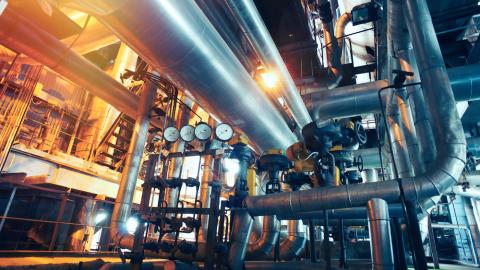Storage: The Key to Climate Solutions
The Challenge
To enable large penetration of renewable energy resources into the electricity sector, it is critical to have the flexibility to store excess power generated at one time and location so it may be used at later times or other locations to help lower the total power capacity needed during peak annual periods. Storage technologies may even need to shift power across seasonal time frames, as solar generation is significantly greater in summer months than in winter months. New solutions are needed to address these issues.
How are we making a difference?
By carrying out early-stage research and rapid technology validation, the Energy Technologies Area (ETA) is working to accelerate the industry’s ability to adopt and commercialize new innovative energy storage technologies. Our researchers combine long-standing expertise in developing novel chemical, electrochemical, and thermal technologies with policy analysis that can demonstrate the economic use case for these new technologies to relevant stakeholders. At ETA, we work closely with academic, government and industry partners to conduct foundational and applied research that provides the groundwork for the development of transformative new energy storage technologies.
The importance of electrochemical energy storage has grown substantially over the past decades as electrification of transportation and integration of alternative energy sources move into widespread implementation. New electrochemical storage systems have to be designed to meet demand for a variety of applications and cycle regimes in the existing and future transportation and grid infrastructure.
Cathode Materials
Breakthrough research at Berkeley Lab
ETA’s strength in synthesis, characterization, and testing offers an opportunity to create new cathode materials that match or exceed the energy density of current Li-ion cathodes but can be produced from less constrained transition metals such as iron, manganese, vanadium, titanium, or molybdenum.
Disordered Rocksalts with Li-eXcess (DRX) materials present a unique opportunity to address both the cost and the resource limitations related to Li-ion battery technology, without sacrificing energy content. Their chemical similarity to current transition metal oxide-based cathodes make them nearly a drop-in replacement for current Li-ion cathodes, mitigating any significant cell and production- line reengineering, as is required for “beyond Li-ion” technologies.
Flow Batteries
Long-duration energy storage
For long-duration storage, ETA is targeting electrochemical technologies that have fundamental advantages at a large scale. Flow batteries are a type of battery system that intrinsically decouples the power and energy that can be useful for achieving scale. As the battery system grows to larger durations, the power block cost stays fixed, whereas the active materials are expanded, reducing the overall cost per kilowatt-hour.
All-Solid-State Batteries
All-solid-state batteries are regarded as one of the future’s most promising energy storage technologies. However, despite their many promising benefits, they still face significant challenges. Berkeley Lab and ETA researchers are addressing these research and development needs.
To advance the capabilities of all-solid-state batteries, ETA is collaborating with the Energy Sciences Area to improve: (1) the fundamental understanding of the function and operation of the battery electrodes, electrolytes, and their interphases and interfaces; (2) solid-state-electrolytes with high ionic conductivity, chemical and mechanical stability, and ease of manufacturing; and (3) new scalable design and architectures of the battery’s passive and active components.
The combination of materials discovery, synthesis, advanced characterization, and device nano-engineering approaches at Berkeley Lab’s user facilities — the National Energy Research Supercomputing Center (NERSC), Advanced Light Source, and Molecular Foundry — show great promise toward overcoming science and technology obstacles, which can lead to technological breakthroughs and improvements in materials and cell-level performance.
Chemical Storage
Chemical energy storage includes hydrogen and other hydrogen-rich chemical energy carriers produced from diverse energy sources. Chemical storage enables high energy density, long-duration/seasonal storage, and the ability to address not only the power sector but industrial and transportation sectors as well. A major challenge for currently utilized and prospective chemical energy storage systems is cost competitiveness with other energy storage media, and ETA researchers are working to find solutions.
Electrolyzers
Improving Hydrogen Production for Fuel Cells
ETA researchers recently developed a unitized reversible fuel cell (URFC) that can boost round-trip efficiencies by combining the electrolyzer and fuel cell into a single device. The unconventional configuration explored involved both electrodes each participating in reacting both hydrogen and oxygen, an approach verified by laboratory experiments, techno-economic analysis, and accelerated stress testing.
Thermal energy storage systems can convert electrical energy to heat and store it with ~98% net efficiency, making it a particularly attractive option for cases in which the end use is thermal. ETA researchers are exploring various routes to optimize thermal energy storage materials and designs, such as creating thermochemical materials that undergo solid-gas reversible chemical reactions with water vapor or developing a composite material capable of converting excess electricity into heat and storing it.
Thermochemical Materials
Phase-change materials for energy storage
Thermochemical materials (TCMs) that undergo solid-gas reversible chemical reaction with water vapor enable users to store and release energy with high storage capacities (600 kWh/m3) and negligible self-discharge, as energy is stored in chemical bonds. This design makes them uniquely suited as compact, stand-alone solutions for daily-seasonal energy storage for residential, district-level, or large commercial buildings.
Thermal Energy Storage Systems
High-temperature thermal energy strorage
To provide cost-competitive thermal energy storage solutions, researchers are developing a composite material capable of converting excess electricity into heat and storing it at temperatures in excess of 2,000°C, from which it can be dispatched up to 100 hours later when demand peaks. The high-grade thermal energy can then be converted back into electricity for the grid, or supplied directly as process heat to industrial manufacturing processes. Such applications otherwise rely on burning fossil fuels to supply steady thermal energy.

Our researchers have made significant progress in developing battery cathodes with a novel family of materials known as DRX, which stands for disordered rocksalts with excess lithium.

Berkeley Lab researchers identify minimum temperature to cost-effectively generate electricity from waste heat

Berkeley Lab-led study assesses cost competitiveness of metal-organic framework materials to store hydrogen for large-scale backup power applications
